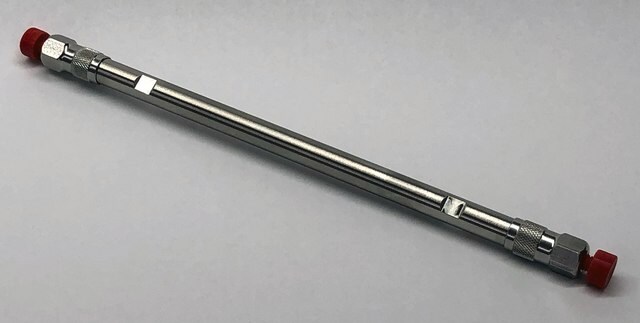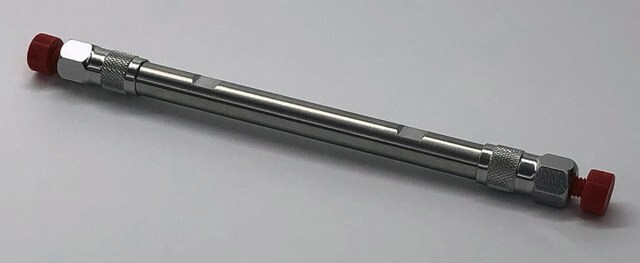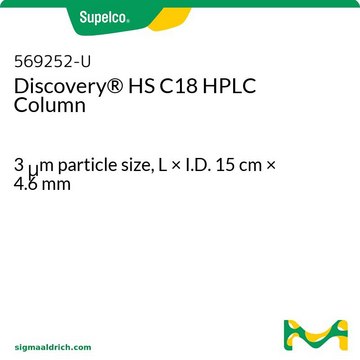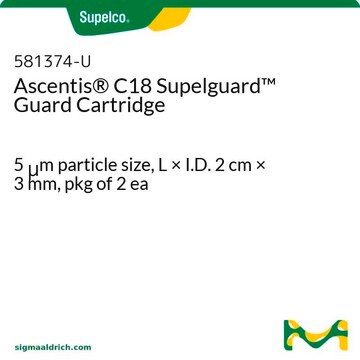581325-U
Ascentis® C18 (5 µm) HPLC Columns
L × I.D. 25 cm × 4.6 mm, HPLC Column
Sinónimos:
Ascentis RP18 HPLC Column
About This Item
Productos recomendados
Nombre del producto
Ascentis® C18 HPLC Column, 5 μm particle size, L × I.D. 25 cm × 4.6 mm
material
stainless steel column
agency
suitable for USP L1 (Similar to Phenomenex Luna C18)
product line
Ascentis®
feature
endcapped
manufacturer/tradename
Ascentis®
packaging
1 ea of
extent of labeling
25% Carbon loading
parameter
≤70 °C temp. range
400 bar pressure (5801 psi)
technique(s)
HPLC: suitable
LC/MS: suitable
L × I.D.
25 cm × 4.6 mm
surface area
450 m2/g
surface coverage
3.7 μmol/m2
impurities
<5 ppm metals
matrix
fully porous particle
silica gel high purity, spherical
matrix active group
C18 (octadecyl) phase
particle size
5 μm
pore size
100 Å
operating pH range
2-8
application(s)
food and beverages
separation technique
reversed phase
¿Está buscando productos similares? Visita Guía de comparación de productos
General description
Ascentis C18 is an extremely stable and reliable first choice HPLC column that gives symmetric peak shape and excellent retention even for difficult compounds.
Application
- Identification of recombinant human insulin and biosynthetic insulin analogues by multiplexed targeted unlabeled mass spectrometry of proteotypic tryptic peptides.: This study utilized the Ascentis® C18 HPLC column for the separation of proteotypic tryptic peptides in the identification of insulin analogues, highlighting its application in targeted mass spectrometry for proteomic analysis (Qasem RJ et al., 2019).
- Development and validation of a novel stability-indicating HPLC method for the simultaneous assay of betamethasone-17-valerate, fusidic acid, potassium sorbate, methylparaben and propylparaben in a topical cream preparation.: This research developed and validated an HPLC method using the Ascentis® C18 HPLC column for the simultaneous assay of multiple compounds, demonstrating its robustness in stability testing of pharmaceutical formulations (Byrne J et al., 2014).
- HPLC-DAD and HPLC-ESI-MS/MS methods for metabolite profiling of propolis extracts.: The study employed the Ascentis® C18 HPLC column for metabolite profiling of propolis extracts using HPLC-DAD and HPLC-ESI-MS/MS, showcasing its effectiveness in complex natural product analysis (Pellati F et al., 2011).
- Practical comparison of 2.7 microm fused-core silica particles and porous sub-2 microm particles for fast separations in pharmaceutical process development.: This article compared different HPLC column technologies, including the Ascentis® C18, highlighting its performance in fast separations critical for pharmaceutical process development (Abrahim A et al., 2010).
Features and Benefits
- Excellent retention
- Symmetric peak shape
- High reproducibility
- Complete LC-MS compatibility
Legal Information
Related product
guard cartridge
Storage Class
11 - Combustible Solids
wgk_germany
nwg
flash_point_f
Not applicable
flash_point_c
Not applicable
Elija entre una de las versiones más recientes:
¿Ya tiene este producto?
Encuentre la documentación para los productos que ha comprado recientemente en la Biblioteca de documentos.
Los clientes también vieron
Protocolos
-glucoside chloride; Malvidin 3-glucoside; Delphinidin 3-(6-acetylglucoside); Cyanidin 3-(6-acetylglucoside); Petunidin 3-(6-acetylglucoside); Peonidin 3-(6-acetylglucoside); Malvidin 3-(6-acetylglucoside); Malvidin 3-(6-caffeoylglucoside); Petunidin 3-(6-cumarylglucoside); Peonidin 3-(6-cumarylglucoside); Malvidin 3-(6-cumarylglucoside)
Nuestro equipo de científicos tiene experiencia en todas las áreas de investigación: Ciencias de la vida, Ciencia de los materiales, Síntesis química, Cromatografía, Analítica y muchas otras.
Póngase en contacto con el Servicio técnico








